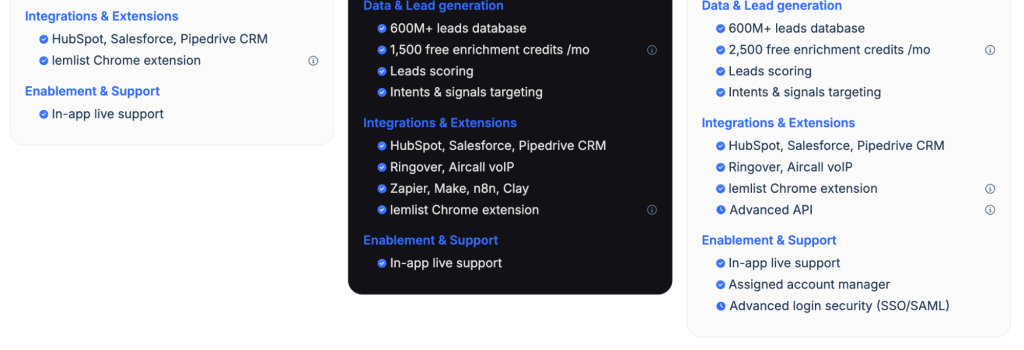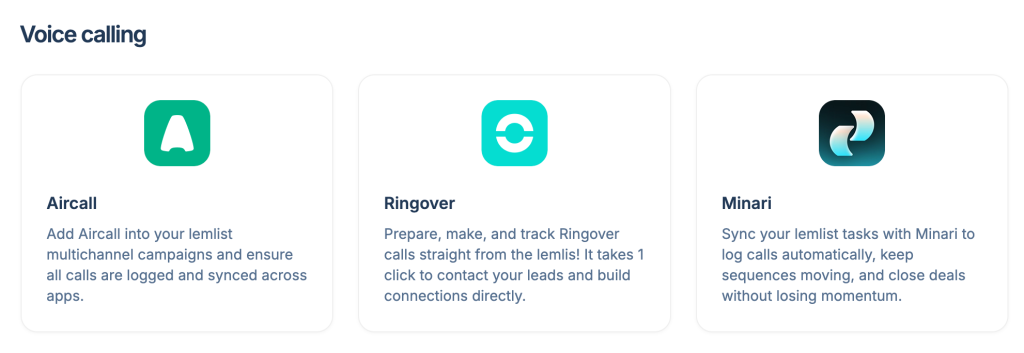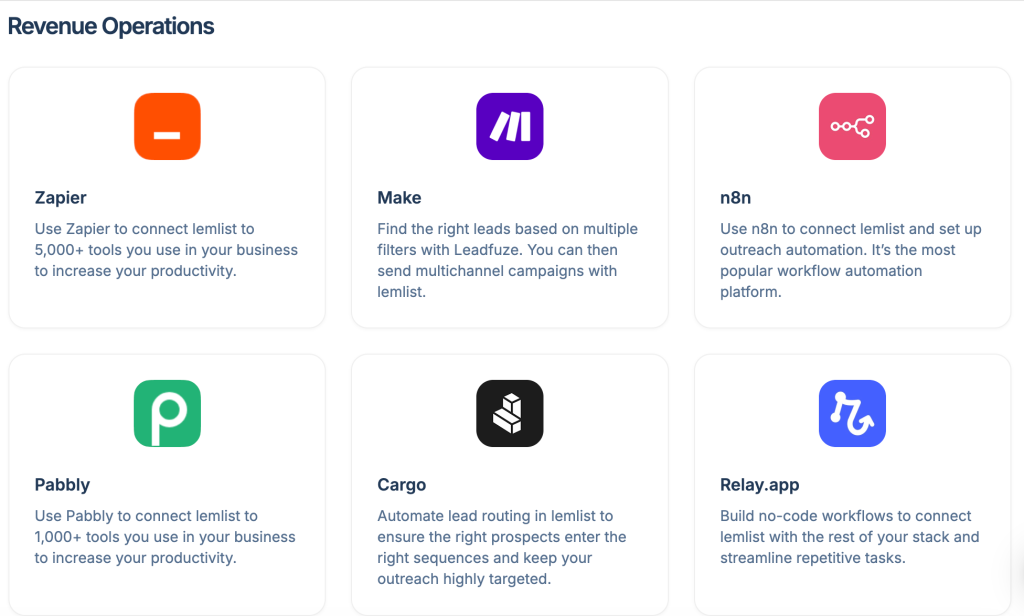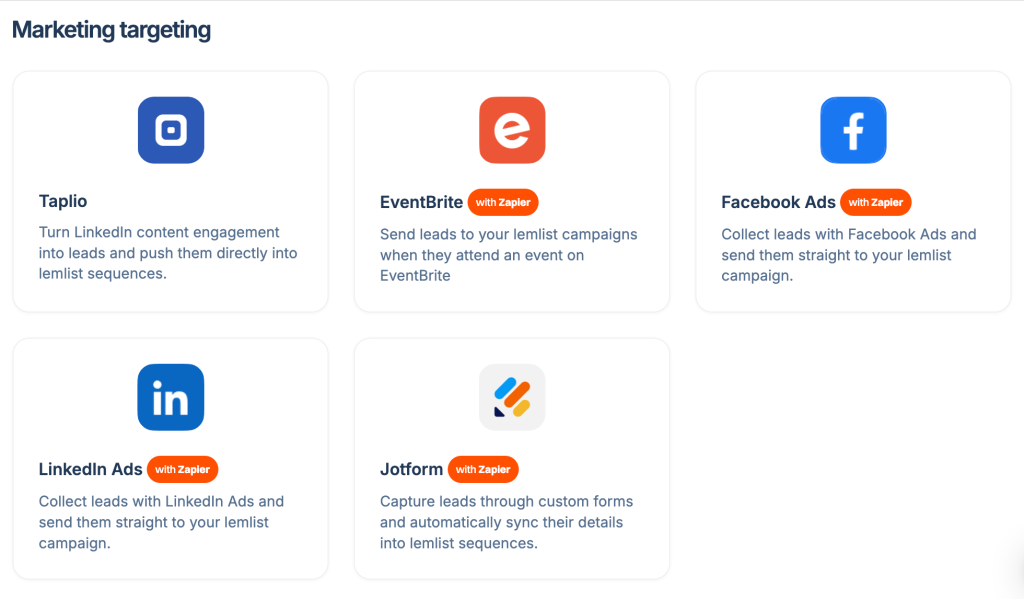At the moment of writing, Lemlist has 56 integrations available to help you create better Lemlist campaigns and get in touch with new leads across deal stages. But are those integrations really valuable for your specific email campaigns, and what can you do with them?
Today, we take a look at the most popular Lemlist integrations to tell you how they can help your email outreach.
Who has access to Lemlist integrations?
Lemlist has no free plan; there is only a free trial available. Depending on which plan you purchase, you get access to different integrations.

Here’s how it works:
- Email Pro (55EUR/user/month): HubSpot, Salesforce, Pipedrive CRM, and Lemlist Chrome extension
- Multichannel Expert (79EUR/user/month): HubSpot, Salesforce, Pipedrive CRM, Ringover, Aircall voIP, Zapier, Make, n8n, Clay, lemlist Chrome extension
- Enterprise (custom pricing): HubSpot, Salesforce, Pipedrive CRM, Ringover, Aircall voIP, Lemlist Chrome extension, Advanced Lemlist API key
If integrations are a key part of your Lemlist activities, you may consider choosing a higher plan to get the kind of integration you need.
Also, you may consider Lemlist alternatives such as Woodpecker that offer a wider choice of integrations in lower plans.
The most popular Lemlist integrations and what you can do with them
On their integrations page, Lemlist sorts the platforms they integrate with in a couple of categories as follows:
- CRM
- Data enrichment
- Voice calling
- Revenue operations
- Intent-based prospecting
- Marketing targeting
- Engagement add-ons
- Pipeline automation
We’ll cover a few from each category below.

CRM integrations in Lemlist

HubSpot
How it works: You connect HubSpot with Lemlist and enable contact, company, and deal data to flow between them, plus outreach activity gets logged in HubSpot.
Why it’s useful: Keeps your outreach and CRM data aligned so cold outreach becomes part of your main pipeline rather than a separate silo in a specific campaign.
Notable use case: For SaaS firms using HubSpot as their CRM and Lemlist for outbound campaigns, this integration bridges outreach and deeper sales tracking.
Salesforce
How it works: Lemlist supports syncing of new leads/contacts, campaign activity (opens, replies) back into Salesforce.
Why it’s useful: Enables enterprises already on Salesforce to connect cold outreach with the rest of their sales workflow and pipeline metrics.
Notable use case: Enterprises using Salesforce want outreach campaigns to feed directly into their sales ops dashboards.
Pipedrive
How it works: You can send contacts from Pipedrive into Lemlist campaigns and push outreach leads or replies back into Pipedrive, keeping your pipeline up to date.
Why it’s useful: For smaller teams or light-sales organizations using Pipedrive, the integration reduces manual exports and keeps outreach linked to the pipeline.
Notable use case: A SaaS startup using Pipedrive for deal tracking and Lemlist for outreach can stay organized without multiple spreadsheets.
Data enrichment Lemlist integrations

UpLead
How it works: UpLead provides verified B2B contact data, which you import directly into Lemlist campaigns.
Why it’s useful: Enables you to build higher-quality prospect lists with fewer missing fields and fewer bounces, improving campaign performance.
Notable use case: A SaaS company targeting niche roles (e.g., “product managers in fintech in Germany”) can use UpLead to find and enrich those contacts before outreach.
Lusha
How it works: Lusha supplies contact information (phone/email), which then flows into Lemlist as part of your lead list preparation.
Why it’s useful: If you need up-to-date contact info for outreach, this integration helps improve deliverability and targeting accuracy.
Notable use case: A seller of a B2B SaaS product needing direct phone numbers for decision-makers could use Lusha + Lemlist instead of cold-calling blind.
Apollo
How it works: Apollo’s contact and company data can be imported directly into Lemlist; lead enrichment helps segment and personalize campaigns.
Why it’s useful: Combines database + enrichment + outreach in one flow, letting you personalize deeply based on enriched fields.
Notable use case: A SaaS with a clearly defined ICP (Ideal Customer Profile) uses Apollo to find matching contacts and then launches Lemlist sequences with enriched personalization.
Voice calling integrations

Aircall
How it works: You integrate Aircall with Lemlist so you can add a “Call” step in your outreach sequence; calls are logged and tracked.
Why it’s useful: Adds a voice channel to your outreach mix and gives you one place to manage calls and email touches together.
Notable use case: A SaaS company doing email outreach, then calling warm leads, can manage both inside a sequence rather than switching tools.
Ringover
How it works: Ringover connects to Lemlist, enabling one-click calls from within your sequence and call activity logged to your campaign.
Why it’s useful: Offers flexibility (especially in regions or teams preferring Ringover) and keeps call steps within your multichannel sequence.
Notable use case: An international SaaS sales team using Ringover as their dialer can embed calls in the outreach flow without needing to memorize extra tools.
Minari
How it works: Minari links tasks and call-logging with Lemlist: you can trigger task creation after certain campaign steps and track follow-ups.
Why it’s useful: Ensures you don’t lose leads after outreach; call steps or task follow-ups are automated so nothing slips through.
Notable use case: For a SaaS service with longer sales cycles where follow-up calls matter, this integration helps maintain momentum post-email.
Revenue operations

Zapier
How it works: This popular workflow automation platform connects Lemlist to thousands of other apps; when a campaign event happens (reply, click, etc), you can trigger actions in other systems (CRM, Slack, Google Sheets, project management tools, etc.).
Why it’s useful: Zapier allows non-technical teams to build custom workflows that link outreach events to other systems without coding.
Notable use case: A SaaS sales ops team wants “when a lead replies in Lemlist, create a deal in CRM + notify Slack” and they can build it via Zapier.
n8n
How it works: n8n is a workflow automation platform; you can set up custom triggers/actions involving Lemlist and other systems for more complex automation.
Why it’s useful: More flexibility than basic automators; good for SaaS ops teams with some technical capacity wanting tailored workflows.
Notable use case: A SaaS company wants “when a lead clicks a link AND visits pricing page AND doesn’t reply after 48h, escalate to SDR” — done via n8n + Lemlist event triggers.
Pipedream
How it works: Another automation platform; you can connect Lemlist with many tools, building event-driven pipelines (e.g., outreach → data update → CRM stage change).
Why it’s useful: Especially useful for tech-savvy teams that want event-driven automation tied to outreach behavior and custom logic.
Notable use case: A SaaS firm might trigger outreach sequences based on product usage events (from product analytics) via Pipedream tied into Lemlist.
Intent-based marketing integrations

Snitcher
How it works: Snitcher identifies anonymous website visitors (companies) and then pushes them into Lemlist campaigns when certain behavior thresholds are met.
Why it’s useful: Moves beyond cold lists to targeted outreach based on actual interest signals (website visits), increasing the likelihood of engagement.
Notable use case: A SaaS inbound-heavy product uses Snitcher to identify mid-market companies visiting their site then initiates personalized outreach via Lemlist.
Phantombuster
How it works: Phantombuster extracts leads from social media Slack/LinkedIn behaviors (such as engagement and mentions) and feeds them into Lemlist sequences.
Why it’s useful: Lets you capture intent or interest outside traditional form/submission channels and act via outreach.
Notable use case: A SaaS product involved in community/Slack discussions uses Phantombuster to identify engaged participants and then contacts them via Lemlist.
Lonescale
How it works: Lonescale monitors target accounts for buying signals, and when an account is “active,” it syncs to Lemlist so you can initiate outreach.
Why it’s useful: Works for account-based sales where outreach triggers are tied to account intent rather than generic lists.
Notable use case: A SaaS enterprise product running ABM uses Lonescale to detect when target accounts show intent, then starts a Lemlist sequence.
Marketing targeting integrations

Taplio
How it works: Taplio captures LinkedIn data and content engagement (people commenting, liking) and then syncs those engaged profiles into Lemlist sequences.
Why it’s useful: Converts social engagement into outreach leads rather than letting them sit passive; better alignment of content and outreach.
Notable use case: A SaaS marketing team posts on LinkedIn, uses Taplio to capture comments on posts, then outreach via Lemlist to those commenters.
EventBrite
How it works: When someone registers/attends an event via EventBrite, that data can be sent to Lemlist so they enter an outreach campaign.
Why it’s useful: Links event marketing with outreach follow-up in a structured sequence rather than a manual post-event email.
Notable use case: A SaaS company hosting webinars/workshops can automatically add attendees to a personalized outreach campaign via Lemlist instead of manually exporting.
LinkedIn Ads
How it works: Leads captured from LinkedIn Ads (lead gen forms) are sent automatically into Lemlist campaigns. You can add leads directly from LinkedIn to Lemlist and register new contacts as potential customers.
Why it’s useful: Rather than letting paid leads sit idle, you immediately flow them into outreach for faster follow-up and engagement.
Notable use case: A SaaS company running LinkedIn lead-gen campaigns uses this to convert form fills into an outbound sequence via Lemlist immediately.
Engagement add-ons

Sendspark
How it works: You can embed personalized video messages via Sendspark inside a Lemlist sequence step (e.g., “send video” step).
Why it’s useful: Video personalization can boost response rates and engagement by adding a human touch to outreach.
Notable use case: A SaaS company reaching out to C-level prospects uses a customized video in the first email step to stand out.
Sendoso
How it works: Sendoso enables sending physical gifts or direct mail, triggered from a Lemlist sequence step.
Why it’s useful: Adds offline/physical dimension to outreach, making it more memorable and higher impact, especially for high-value targets.
Notable use case: A SaaS enterprise vendor targeting large accounts uses a handwritten gift (via Sendoso) post-email step to boost conversion rates.
Handwrytten
How it works: The integration allows you to trigger handwritten-note sending via Handwrytten as part of your sequence inside Lemlist.
Why it’s useful: Premium outreach touch that can differentiate in crowded inboxes, especially for enterprise-level targets.
Notable use case: A SaaS sales team reaching out to board-level executives includes a handwritten note step for top prospects before a follow-up email.
Pipeline automation

SureTriggers
How it works: You can use SureTriggers to sync lead data or automate tasks triggered by Lemlist events across your pipeline and other tools.
Why it’s useful: Automates stages of pipeline work: e.g., when a lead replies, automatically change deal stage or assign to SDR, without manual action simply by choosing triggers and actions that happen as a consequence.
Notable use case: A SaaS company wants to move leads from “outreach” to “qualified” automatically when a reply comes in, and puts them into CRM pipeline stage.
Salesmsg
How it works: You can embed SMS or call steps via Salesmsg inside your Lemlist sequence and automate next-step pipeline updates based on responses.
Why it’s useful: Adds multi-channel pipeline motion (not just email) and reduces manual follow-up by automating pipeline trigger events.
Notable use case: For SaaS with a short sales cycle, after email outreach, you trigger an SMS step, and if the lead books a demo, you automatically advance the deal stage.
Google Sheets
How it works: Sync leads to/from Google Sheets with Lemlist events; for instance, feeding leads into a sheet for easy tracking and logging responses back.
Why it’s useful: Ideal for smaller teams or simpler stacks; automated logging and tracking without needing a full CRM, yet still automating pipeline oversight.
Notable use case: Early-stage SaaS startup uses Google Sheets as a lightweight pipeline tracker; leads from a Lemlist campaign get logged automatically and statuses are updated based on replies.
Wrapping up
While Lemlist offers a wide range of integrations, most of them will require an expensive plan to get started. On the other hand, Woodpecker gives all users access to integrations from the get-go, without forcing you to use third-party tools such as Zapier.
With direct two-way syncing for CRMs such as Pipedrive and HubSpot, contact enrichment from apps like Clay, and easy connections to tools for analytics, reporting, and team collaboration, Woodpecker’s integrations are built for practical daily use.
Explore our integrations today and get started with Woodpecker for free.

